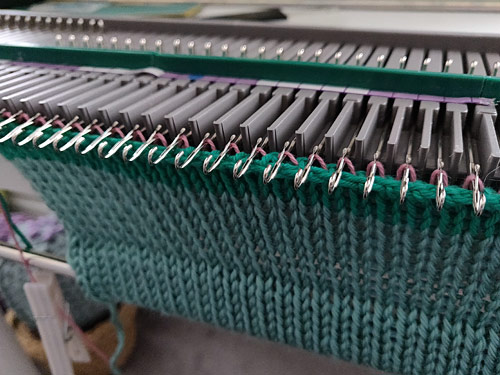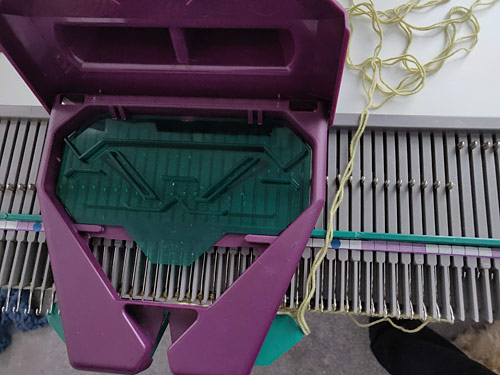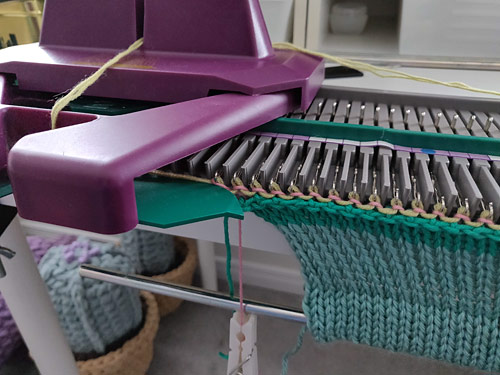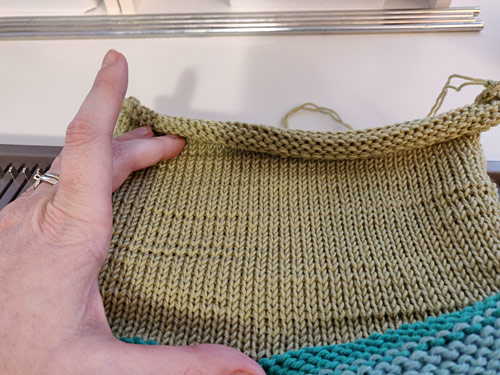Well yes, I seem to have picked up another new fibre-crafting hobby!
A few weeks ago, I somehow ended up on Facebook Marketplace, and noticed someone in my neighbourhood was selling something called the Ultimate Sweater Machine…

It’s the ultimate!
I mean, how could I pass that up?! It even has the prestigious “As Seen on TV” award 😉
I knew nothing about machine knitting, but I love crafting tools and learning new skills, so I couldn’t resist.
The machine was complete but for the instruction manual and – oh! the tragedy! – the patterns for the ’90s-chic designs pictured on the box. It did come with some instructions, but I have no way to view them…

Yep, this is old!
I began to question the sanity of my purchase, but thank goodness for YouTube – there were plenty of tutorials there to get me started. I clamped the machine to the front of a desk and I was ready to go:

I got lucky – the machine matches the length of my desk perfectly
My machine is about as simple as it gets. It only knits stockinette, and there’s no motor or electronics or automation – you operate it by pushing the carriage back and forth across the row of latch hooks. One pass equals one row of stockinette.

Pretty latch hooks, all in a row
In case you’re like me and wondering how on earth this works, here’s a 10-second explanation: inside the purple carriage, the angled bars on the green plate direct the raised peg near the back of each hook, which pushes each hook in and out as you move the carriage along. The hook is moved forwards to grab the yarn in the open latch, and then moved backwards, which closes the latch, draws the new yarn through the existing stitch, and drops the old stitch off the hook.

It’s a simple but clever mechanism
It’s possible to make increases, decreases, lace and cables with the machine, but you have to move each stitch in turn into its new position (which takes ages) before you knit each row – it’s a completely manual process.
(If you wanted to do ribbing, or any other stitch pattern consisting of both knits and purls, there’s no way to do that except to drop every stitch that should be a purl, and hook it back up in the other direction with a crochet hook or latch hook – I’m not sure if you’d save much time at all after all that faffing around!)
After a few stitch-dropping fiascos, I got the hang of the machine and knitted a rag hem (a reusable provisional weighted hem). The machine is incredibly fast when you’re just knitting back and forth – it just takes a couple of seconds to knit a full row!

Woohoo! I knitted something on the machine!
I made two more rag hems, both for practice using the machine and as gauge swatches for my first ‘proper’ project (blog post coming soon…)
And here’s the rag hem in action as I start swatching for another project:
- The weighted rod slides inside the bottom edge of the hem to weigh down the project
- The pink thread temporarily attaches the project to the hem
- The yellowish-green yarn is the first row of my project

Rag hem in action
Here’s the finished swatch before I bound it off. It looks pretty strange, because the stitches are hugely stretched out across the machine, and the front of the fabric faces away from you as you knit:

Knitting in progress (with the rag hem at the bottom)
After removing the project from the machine, the stretched stitches retract back into regular knitted fabric. Flip it over, and you have rows and rows of stockinette:

Looks like knitting!
I have big plans for this machine – in theory, I should be able to design a handknit sweater and knit my design much more quickly than on manual needles. You may consider it cheating, but I’ll still have to form every increase and decrease myself at the right places, and do all the assembly and knit the ribbing by hand. It’s just a different way to knit, and I think I’m going to enjoy it!
Have you ever tried machine knitting? Or do you think it’s cheating to use a machine?!
I’d love to hear about your experiences, or if you have any resources or tips to share. Let me know in the comments below!
















Mhairie Lee said
I’ve been using a bond for many years and love it! yes you have to hand manipulate stitches if you want to do a pattern but its not as tedious as it may seem, I’ve made heaps if gaments over the years for myself and family and charity. I dont know why people would consider it as cheating for, thats just silly, its a tool just like a crochet hook or knitting needle, i like this tool because of its simplicity, its obviously not as portable, but thats when i use knitting needles or crochet hooks, even with needing to do manual manipulation its still faster than hand knitting. if you go to the caron website there is a list of tutorials that are easy to understand, and theres a number of people on youtube that have tutorials, the answerlady is one and a lady called Roberta cant remember last name they do tutorials on different things using the bond. have fun with your new tool. cheers!
Alva said
i have the ultimate sweater machine and a brother home knitter, have tried them both years ago. Kind of disappointing, but looking forward to pulling them out again soon and trying again!
judy penney said
have the original Bond, and several sweaters, still wearing them . Now knitting on the true flat beds with ribbers and cards thst help you make patterns and interesting stitches. you are just starting on what may be a wonderful adventure
Frances Harrison said
i have two knitting machines in my basement and im going to unpack them. one is a single bed Singer, the other is a double bed Passap. I also have books. I havent used then in quite a few years
Bea said
Hi!
I have recently got a knitting machine myself and I am also absolutely loving it!
A friend of mine happened to have one from her grandma and she showed it to me some time ago — I was immediately fascinated! When my friend decided to upgrade to a “double bed” machine* for Christmas, I bought her old one.
*Sorry, I’m not sure if they are called like this in English — they are basically like 2 of these machines opposed in a 90º angle and they allow ribbing, brioche and some other techniques that a “regular” machine can’t manage.
I don’t think it is cheating at all since, as you very well described, you still require _a lot_ of manual work in order to get to your final product, it only makes the repetitive stockinette sections faster (_way_ faster, that’s true ;))
I still have a lot to learn and investigate about these machines, I’ll be following your posts! 😀
June said
Sounds like yours is much fancier than mine, Bea! I’m a bit jealous. 😉
I can see this whole machine knitting thing is a rabbit hole I could get lost in… but then again, I think I should master the machine I have before I even consider looking at a better one! I’ve done some research and ordered a book that looks like a really solid manual, so I’ll have lots of techniques to try soon enough – I’ll report back when I’ve made some progress…
Celine said
I know exactly how you feel! Back in the 80s I was living in Hawaii and came across an old knitting machine with all Japanese markings (a Brother KH521) in a thrift shop for only $2! How could I resist? I had never even seen a knitting machine, and certainly had no knowledge of Japanese whatsoever, but I loved my wonderful bargain. This was pre-internet days and it took me a few years to round up enough information to make sense of my machine, but I succeeded and made sweaters for my kids. It still works! I have since acquired ribbers and a KH588 and, yes, a Bond Ultimate Sweater Machine. The first time I googled that machine, I got some horrifying though educational results based on bondage, sweating, ultimate, and even machines.
As for anyone who suggests that machine knitting is not really knitting, pfft. Instead of one needle with 100 stitches, it is 100 needles each with a stitch of its own. Both knitting styles require a lot of skill and dexterity.
No one accuses sewers who use a sewing machine of “not really” sewing or cheating!
June said
Ooh, Celine, I bet your Japanese machine is top quality, and the best bargain ever at only $2 – that’s amazing! Such a lucky find.
Yes, I’m lucky to be coming to my machine in the internet age; it must have been a real struggle to get started without being able to google for any problems you encountered, let alone the Japanese language barrier. Luckily I’ve been able avoid any sweaty bondage results in my searches… :flushed:
And you make a very good point that this is comparable to the difference between hand and machine sewing – I hadn’t thought of that, but I think it’s a fair comparison. I think the outside perception of a knitting machine is that you select ‘sweater, size small’, load the yarn, press ‘go’, and wait for your finished sweater to pop out!
Kathleen Milkowski said
i have the machine that followed that one( version 2.0..lol). I’ve done a few smaller items and a couple bany blankets. I don’t know if ou have the extension piece that comes with that or not but it’s hreat for largr items. You do want to invest in some parafin wax to keep your slide from freezin in position or being sticky( I found that out the hard way but jut a light coating on the slide oherwise it stains the yarn)! I’m not he strongest knitter but I can honestly say that it’s the best gift a high school son working ina craft store because he knows how much Mom loves stuff like that and his discount sure comes in handy!
Take your time and enjoy it!
June said
Aww, so you mean mine isn’t really the ultimate, Kathleen?! That’s so disappointing, haha!
I don’t have the extension piece (mine didn’t come with any of the optional extras I’ve since read about), but I think 100 stitches should be enough for my needs, and my desk isn’t long enough for the extension piece anyway!
I already discovered the difference that waxing the keyplates makes, but which part is the slide? The part I’m waxing doesn’t touch the yarn – maybe I’m missing something? I’m sure I’m missing lots of things; I’m still a rank beginner here, but I’m enjoying the challenge. :slight_smile: